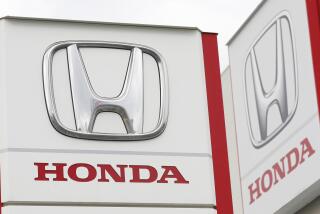Ford to Retrofit Police Cruisers
- Share via
DETROIT — Under pressure from law enforcement agencies, Ford Motor Co. said Friday that it would the reinforce fuel tanks on hundreds of thousands of Crown Victoria police cars in an attempt to prevent more accidents of the kind that have burned to death at least 10 police officers.
Consumer advocates praised the move but said the action fell short because it excludes civilian versions of the car with the same gas tank design.
Ford said it would install rubber and plastic shields around the fuel tanks to help prevent them from puncturing and bursting into flames if the police car is rammed from behind, as has happened in numerous cases.
The world’s No. 2 automaker also will provide a special container to hold sharp objects in the trunk that could puncture the gas tank and set up a Web site for police to maintain communication about avoiding punctures and accidents.
“No automaker can prevent accidents, but we’ve advanced the state of the industry by taking developmental testing to an unprecedented level,” Ford’s vice president for safety and environmental engineering, Sue Cischke, said at a news conference in Phoenix.
Ford set up a technical task force and a blue-ribbon panel that studied the problem for three months. Cischke made the announcement in Phoenix because the automaker was spurred to investigate the matter by Arizona Atty. Gen. Janet Napolitano, who said the state would stop buying the vehicles after three Arizona Highway Patrol officers died in fires in the modified cars known as Crown Victoria Police Interceptors.
There are 350,000 Crown Victoria police cruisers on the road, “and all will be retrofitted,” Napolitano said at the news conference. “I hope and plan that all the retrofits will be done by January.”
Ford would not say what the fixes would cost.
Consumer advocates said that a move to retrofit the cars was needed but that Ford should recall all Crown Victorias sold to consumers, as well as Mercury Grand Marquis and Lincoln Town Car sedans, which are built on similar platforms. There are about 3 million of such Panther platform cars on the road, including police cruisers.
Safety advocates also questioned whether Ford’s testing would be sufficient.
Ford’s proposed fix should be tested by the National Highway Traffic Safety Administration or another independent source to confirm whether occupants who survive a rear impact of 80 mph or more won’t die in an ensuing fire, said Joan Claybrook, president of the consumer group Public Citizen.
“In 1978, when Ford agreed to recall the Pinto, NHTSA conducted its own crash tests, and these tests showed Ford’s proposed remedy was inadequate and needed to be upgraded significantly before NHTSA would approve a recall,” said Claybrook, who headed the agency from 1977 to 1981.
Regulators should rigorously examine Ford’s proposals because the gas tanks should not explode even in a high-speed impact, said Clarence Ditlow, executive director of the Center for Auto Safety in Washington.
“Although Ford has tried to mislead the public into believing the fire crashes in Crown Victorias are unsurvivable due to high speed,” he said, “they are generally survivable because the Crown Victoria has so much crush space and strong seats to absorb the energy of the crash.”
Cischke said that the cars have a good safety record and don’t need to be recalled and that retrofitting would be done only to Police Interceptor models and not to sedans sold to the public.






